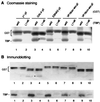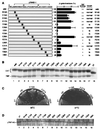A role of transcriptional activators as antirepressors for the autoinhibitory activity of TATA box binding of transcription factor IID
- PMID: 10852950
- PMCID: PMC16519
- DOI: 10.1073/pnas.120074297
A role of transcriptional activators as antirepressors for the autoinhibitory activity of TATA box binding of transcription factor IID
Abstract
The TATA box-binding activity of transcription factor IID (TFIID) is autoinhibited by the N-terminal domain of the Drosophila TATA box-binding protein- (TBP) associated factor 230/yeast TBP-associated factor 145 subunit, which binds to the TATA box-binding domain of TBP by mimicking the TATA box structure. Here, we propose a mechanism of transcriptional activation that involves antirepression of this autoinhibitory activity by transcriptional activators. Like the autoinhibitory domain of TFIID, various acidic activators interact with the TATA box-binding domain of TBP. Moreover, the autoinhibitory domain of TFIID, which is known to interact with only the TATA box-binding domain of TBP, acts as an activation domain when fused to the GAL4 DNA-binding domain, indicating that interaction with the TATA-binding domain of TBP is crucial for activation of transcription. In a reciprocal fashion, the acidic activation domains can function as the autoinhibitory domain when the latter is replaced by the former within TFIID. These results indicate that activation domains and the autoinhibitory domain of TFIID are interchangeable, supporting a role for transcriptional activators as antirepressors of the autoinhibitory activity of the TATA box binding of TFIID.
Figures






Similar articles
-
Drosophila TAF(II)230 and the transcriptional activator VP16 bind competitively to the TATA box-binding domain of the TATA box-binding protein.Proc Natl Acad Sci U S A. 1997 Jan 7;94(1):85-90. doi: 10.1073/pnas.94.1.85. Proc Natl Acad Sci U S A. 1997. PMID: 8990165 Free PMC article.
-
Even-skipped represses transcription by binding TATA binding protein and blocking the TFIID-TATA box interaction.Mol Cell Biol. 1998 Jul;18(7):3771-81. doi: 10.1128/MCB.18.7.3771. Mol Cell Biol. 1998. PMID: 9632760 Free PMC article.
-
Interaction between the N-terminal domain of the 230-kDa subunit and the TATA box-binding subunit of TFIID negatively regulates TATA-box binding.Proc Natl Acad Sci U S A. 1994 Apr 26;91(9):3520-4. doi: 10.1073/pnas.91.9.3520. Proc Natl Acad Sci U S A. 1994. PMID: 8170939 Free PMC article.
-
Mechanisms of transcriptional activation and repression can both involve TFIID.Philos Trans R Soc Lond B Biol Sci. 1996 Apr 29;351(1339):517-26. doi: 10.1098/rstb.1996.0050. Philos Trans R Soc Lond B Biol Sci. 1996. PMID: 8735274 Review.
-
Role of the TATA-box binding protein (TBP) and associated family members in transcription regulation.Gene. 2022 Jul 30;833:146581. doi: 10.1016/j.gene.2022.146581. Epub 2022 May 18. Gene. 2022. PMID: 35597524 Review.
Cited by
-
Molecular genetic dissection of TAF25, an essential yeast gene encoding a subunit shared by TFIID and SAGA multiprotein transcription factors.Mol Cell Biol. 2001 Oct;21(19):6668-80. doi: 10.1128/MCB.21.19.6668-6680.2001. Mol Cell Biol. 2001. PMID: 11533254 Free PMC article.
-
Mutations in the histone fold domain of the TAF12 gene show synthetic lethality with the TAF1 gene lacking the TAF N-terminal domain (TAND) by different mechanisms from those in the SPT15 gene encoding the TATA box-binding protein (TBP).Nucleic Acids Res. 2003 Feb 15;31(4):1261-74. doi: 10.1093/nar/gkg180. Nucleic Acids Res. 2003. PMID: 12582246 Free PMC article.
-
TAF(II)170 interacts with the concave surface of TATA-binding protein to inhibit its DNA binding activity.Mol Cell Biol. 2001 Nov;21(21):7523-34. doi: 10.1128/MCB.21.21.7523-7534.2001. Mol Cell Biol. 2001. PMID: 11585931 Free PMC article.
-
SAGA binds TBP via its Spt8 subunit in competition with DNA: implications for TBP recruitment.EMBO J. 2006 Aug 23;25(16):3791-800. doi: 10.1038/sj.emboj.7601265. Epub 2006 Aug 3. EMBO J. 2006. PMID: 16888622 Free PMC article.
-
The Ccr4-not complex and yTAF1 (yTaf(II)130p/yTaf(II)145p) show physical and functional interactions.Mol Cell Biol. 2002 Oct;22(19):6735-49. doi: 10.1128/MCB.22.19.6735-6749.2002. Mol Cell Biol. 2002. PMID: 12215531 Free PMC article.
References
Publication types
MeSH terms
Substances
LinkOut - more resources
Full Text Sources
Molecular Biology Databases

